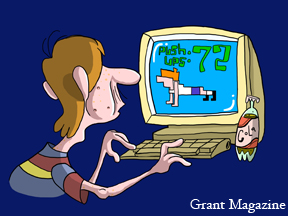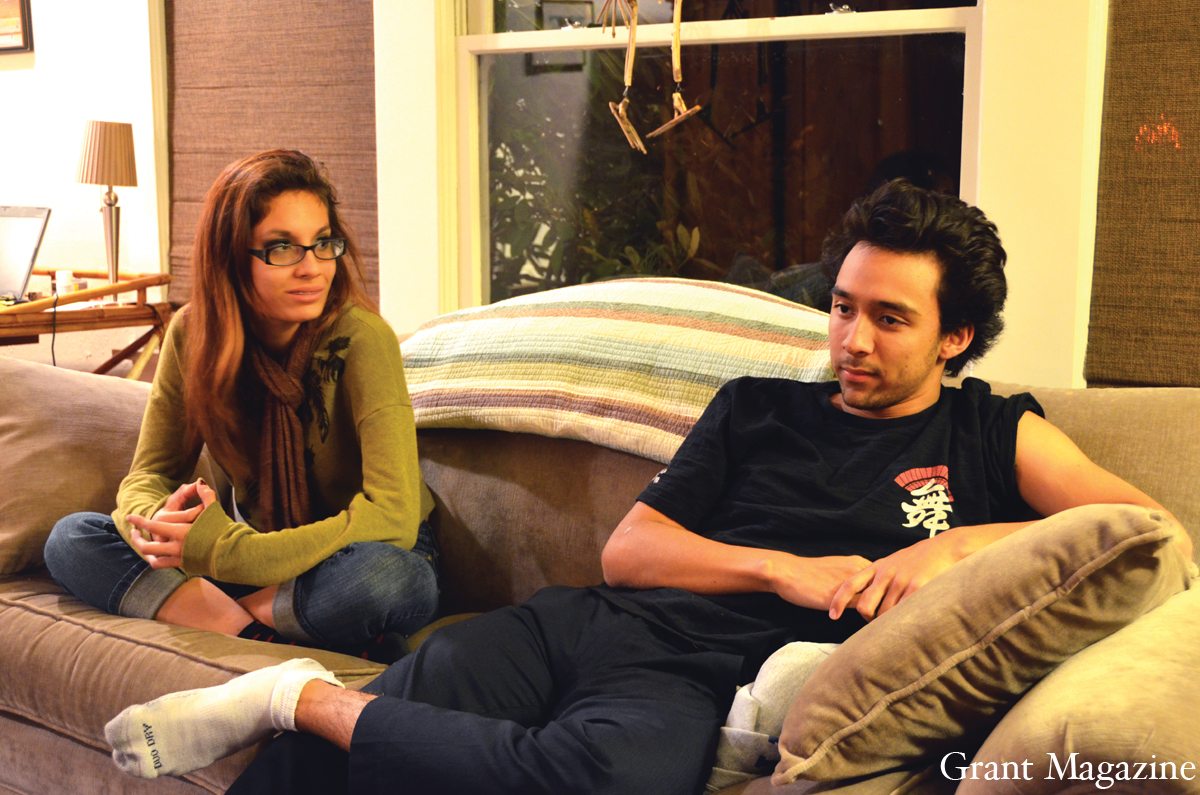
It’s 8:15 a.m. on a Thursday at Grant High School and the Lifetime Activities physical education class is in motion. The girls start out the daily activities by running laps outside around the gym as the boys all jump rope.
The genders alternate the two activities for about 20 minutes before moving to the weight room. Then it’s time for a sheet volleyball tournament, where students work in teams, using sheets to launch the volleyball back and forth.
For Grant sophomore Adrian Galash, gym class had a different setting.
In August, Galash, 15, sat in his best friend’s dining room, hunched over a Scantron test sheet for his online P.E. class. He completed 12 tests in five hours, accomplishing in one day the graduation requirement that most students finish in a year.
Galash chose to skip P.E. class at Grant altogether and take an online course, which he completed rather rapidly. “They just kinda have to trust you in order to give you the credit,” Galash says now.
It’s an honor system he didn’t hesitate to take advantage of. And Galash isn’t alone.
Online P.E. is growing in popularity in Portland and across the nation. Last year marked one of the first times that Grant offered online physical education classes. This year, the number of students taking such classes has risen as more students opt out of the actual class.
Some say the flexibility that online education offers is a valuable facet of today’s educational system. But online P.E. is different, critics say.
A lot of kids simply don’t like dressing down for gym, P.E. teachers complain. Many students don’t like being sweaty at school after physical activity. But there’s something else that online P.E. takes away from students: staying fit.
With the continuing rise in childhood obesity, diabetes and other ailments that threaten kids’ health, online P.E. offers a way out of the daily exercise that appears to be sorely needed by high school students. In 2010, more than one third of children and adolescents living in America were obese or overweight. Cardiovascular disease and childhood diabetes are also on the rise.
According to the Centers for Disease Control and Prevention, there are 600,000 deaths caused by heart disease each year in the United States.
Some suggest physical education taught online is a paradox, considering how easy it is for students to falsely record activity while still earning credit for little to no physical effort. It’s hard to demonstrate true understanding and performance of physical activity by filling out a multiple-choice quiz.
“I think it’s crap,” said Grant physical education teacher Debbie Engelstad. “There is no accountability. Where is the validation and who is holding them accountable?”
“I think what you learn from online P.E. are the wrong things, like how to cheat the system, how to pay for a credit, and how to get mom and dad to sign off on things.” -Debbie Engelstad
In traditional P.E. classes, teachers monitor activities. They make sure everyone participates and keep an eye out for those who falter. Engelstad feels strongly that students taking P.E. online are missing out. “I really believe in what I do,” says Engelstad, a Grant graduate who has taught P.E. for more than 20 years. “I think that the experience that one receives in a class setting is invaluable, and I don’t think you can get that in an online class.”
Bill Griffin also teaches P.E. at Grant. He says the online version is a waste of money, and students aren’t getting the social interactions they get in the classroom. In a recent class, Griffin shouts “way to raise that metabolism” to students spread across the gym floor, knees bent, attempting to get to 100 crunches.
Like many teachers, Griffin is skeptical of online physical education programs. “You can’t legitimize the work,” he says.
That didn’t stop Galash and other students like him from choosing online P.E. One grievance against regular P.E. class that many students hold is “dressing down” in Grant’s standard gym uniform – blue shorts and a white T-shirt. Many also complain that gym makes them sweaty for the rest of the school day.
Galash says he simply didn’t want to put up with P.E. class. “One of the reasons why I didn’t want to take P.E. at school was because I didn’t want to bring a change of clothes to school everyday, and never having enough time to actually shower after class,” he says.
He also wanted to be free to take beginning theater as an extra elective, though the timing didn’t work out and he was unable to sign up. He describes the online class as not as challenging as he had hoped. “It took maybe five hours while I was working with a friend,” he explains, saying it’s very easy to cheat.
His mom, Ida Galash, says the family went through all the hoops, paid the money, and they still didn’t get the theater class that they wanted.
His dad, Neal Galash, thinks the online program is a cheap scheme. “The intent is to make money,” he says.
Both parents said they didn’t really research the program and signed him up on a whim. Ida Galash says it should be up to the students to hold themselves accountable, including her son. “We’re not really micromanaging,” she says.
Sophomore Lily Bourquein took online P.E. last summer, too. “For the weightlifting piece, I was so confused,” she recalls. “So I ended up cheating a little bit.”
Olivia Bozarth, another sophomore, says when she took online P.E. it was hard to navigate. “It’s easy to do a lot of the lessons at once, but I didn’t know this at first,” she says. After completing her half credit of online P.E. during the summer of 2012, she says she hadn’t really learned anything she didn’t already know.
This sent her into a cram session a few weeks before the class ended, as she hurried to take her final exam. She went through her second session of online P.E. with ease, finishing the jogging class in about three months versus the six that it takes in school.
Engelstad remembers a student who took online P.E. last year. She says he would describe his daily class activity as going to the Multnomah Athletic Club, ordering a milkshake and watching ESPN for a couple of hours. And he got the credit.
Engelstad sums it up like this: “If the company gets your money, you’re going to get your credit. There is no value in that.”
But some argue that if you play a sport that requires daily practice, online P.E. should be an option to fulfill the requirement.
“If you’re taking the class because you don’t want to run across the gym, there is a problem,” says Jessie Ray, a sophomore who plays girls varsity soccer. But it can be a good alternative for athletes who get plenty of exercise outside of school.
Senior and football player Lynn Owens took P.E. his freshman year and enjoyed the class taught by Engelstad. “She worked us out but still let us have fun,” he admits. He said he liked gym but would’ve taken the online class instead to get ahead on his credits.
Sophomore Josie Ruff, like many others, puts less than maximum effort into her first period P.E. class, often half-assing the activities to save energy for the rest of the day. “It’s a complete waste of time,” says another sophomore.
Some students, though, do appreciate physical education class.
Sophomore Austin Holt says that P.E. keeps you active and fit. Holt’s weight training class is one of his favorites. “I hate sitting in desks in a classroom for so long,” he says. The physical activity during P.E. balances out the monotony of his other classes.
At Benson High School, gym teachers Linda McLellan and Katie Meyers created a new program called “Fit 2 Live and Learn.” They decided to blend health and P.E. classes into one course.
McLellan believes anyone looking to get fit must lace up a pair of shoes, do some type of “moderate to vigorous movement” and sweat on a regular basis. Online P.E. “suggests we can learn and demonstrate physical fitness, strategy, teamwork, movement, skills cooperation, and appreciation for diversity by reading articles without actually moving,” she muses.
At Grant, Engelstad and the other gym teachers are working to adopt the Fit 2 Live program. They hope to have the curriculum in place next year.
“I think it will be fun and I’m really excited,” says Engelstad. She explains that “kids starting next year will have finished pretty much their freshman year with the health and P.E. requirements.”
The soon-to-be-adopted class will be half health and half physical education every day of the week, which makes it possible for students to gain both credits. “It will be awesome,” says Engelstad. ♦




